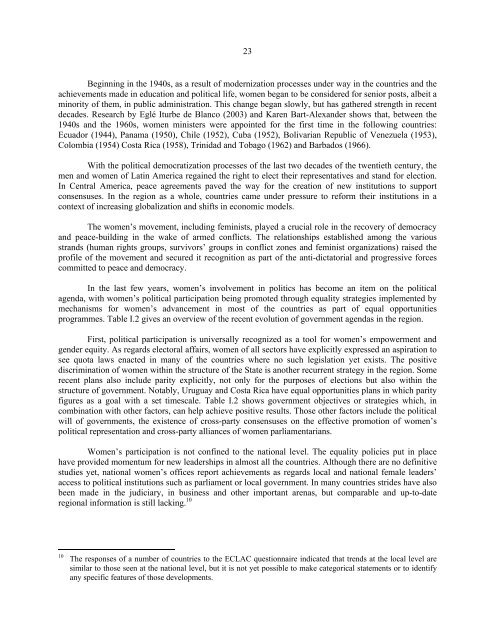Women in Latin America and the Caribbean - Cepal
Women in Latin America and the Caribbean - Cepal
Women in Latin America and the Caribbean - Cepal
Create successful ePaper yourself
Turn your PDF publications into a flip-book with our unique Google optimized e-Paper software.
23<br />
Beg<strong>in</strong>n<strong>in</strong>g <strong>in</strong> <strong>the</strong> 1940s, as a result of modernization processes under way <strong>in</strong> <strong>the</strong> countries <strong>and</strong> <strong>the</strong><br />
achievements made <strong>in</strong> education <strong>and</strong> political life, women began to be considered for senior posts, albeit a<br />
m<strong>in</strong>ority of <strong>the</strong>m, <strong>in</strong> public adm<strong>in</strong>istration. This change began slowly, but has ga<strong>the</strong>red strength <strong>in</strong> recent<br />
decades. Research by Eglé Iturbe de Blanco (2003) <strong>and</strong> Karen Bart-Alex<strong>and</strong>er shows that, between <strong>the</strong><br />
1940s <strong>and</strong> <strong>the</strong> 1960s, women m<strong>in</strong>isters were appo<strong>in</strong>ted for <strong>the</strong> first time <strong>in</strong> <strong>the</strong> follow<strong>in</strong>g countries:<br />
Ecuador (1944), Panama (1950), Chile (1952), Cuba (1952), Bolivarian Republic of Venezuela (1953),<br />
Colombia (1954) Costa Rica (1958), Tr<strong>in</strong>idad <strong>and</strong> Tobago (1962) <strong>and</strong> Barbados (1966).<br />
With <strong>the</strong> political democratization processes of <strong>the</strong> last two decades of <strong>the</strong> twentieth century, <strong>the</strong><br />
men <strong>and</strong> women of Lat<strong>in</strong> <strong>America</strong> rega<strong>in</strong>ed <strong>the</strong> right to elect <strong>the</strong>ir representatives <strong>and</strong> st<strong>and</strong> for election.<br />
In Central <strong>America</strong>, peace agreements paved <strong>the</strong> way for <strong>the</strong> creation of new <strong>in</strong>stitutions to support<br />
consensuses. In <strong>the</strong> region as a whole, countries came under pressure to reform <strong>the</strong>ir <strong>in</strong>stitutions <strong>in</strong> a<br />
context of <strong>in</strong>creas<strong>in</strong>g globalization <strong>and</strong> shifts <strong>in</strong> economic models.<br />
The women’s movement, <strong>in</strong>clud<strong>in</strong>g fem<strong>in</strong>ists, played a crucial role <strong>in</strong> <strong>the</strong> recovery of democracy<br />
<strong>and</strong> peace-build<strong>in</strong>g <strong>in</strong> <strong>the</strong> wake of armed conflicts. The relationships established among <strong>the</strong> various<br />
str<strong>and</strong>s (human rights groups, survivors’ groups <strong>in</strong> conflict zones <strong>and</strong> fem<strong>in</strong>ist organizations) raised <strong>the</strong><br />
profile of <strong>the</strong> movement <strong>and</strong> secured it recognition as part of <strong>the</strong> anti-dictatorial <strong>and</strong> progressive forces<br />
committed to peace <strong>and</strong> democracy.<br />
In <strong>the</strong> last few years, women’s <strong>in</strong>volvement <strong>in</strong> politics has become an item on <strong>the</strong> political<br />
agenda, with women’s political participation be<strong>in</strong>g promoted through equality strategies implemented by<br />
mechanisms for women’s advancement <strong>in</strong> most of <strong>the</strong> countries as part of equal opportunities<br />
programmes. Table I.2 gives an overview of <strong>the</strong> recent evolution of government agendas <strong>in</strong> <strong>the</strong> region.<br />
First, political participation is universally recognized as a tool for women’s empowerment <strong>and</strong><br />
gender equity. As regards electoral affairs, women of all sectors have explicitly expressed an aspiration to<br />
see quota laws enacted <strong>in</strong> many of <strong>the</strong> countries where no such legislation yet exists. The positive<br />
discrim<strong>in</strong>ation of women with<strong>in</strong> <strong>the</strong> structure of <strong>the</strong> State is ano<strong>the</strong>r recurrent strategy <strong>in</strong> <strong>the</strong> region. Some<br />
recent plans also <strong>in</strong>clude parity explicitly, not only for <strong>the</strong> purposes of elections but also with<strong>in</strong> <strong>the</strong><br />
structure of government. Notably, Uruguay <strong>and</strong> Costa Rica have equal opportunities plans <strong>in</strong> which parity<br />
figures as a goal with a set timescale. Table I.2 shows government objectives or strategies which, <strong>in</strong><br />
comb<strong>in</strong>ation with o<strong>the</strong>r factors, can help achieve positive results. Those o<strong>the</strong>r factors <strong>in</strong>clude <strong>the</strong> political<br />
will of governments, <strong>the</strong> existence of cross-party consensuses on <strong>the</strong> effective promotion of women’s<br />
political representation <strong>and</strong> cross-party alliances of women parliamentarians.<br />
<strong>Women</strong>’s participation is not conf<strong>in</strong>ed to <strong>the</strong> national level. The equality policies put <strong>in</strong> place<br />
have provided momentum for new leaderships <strong>in</strong> almost all <strong>the</strong> countries. Although <strong>the</strong>re are no def<strong>in</strong>itive<br />
studies yet, national women’s offices report achievements as regards local <strong>and</strong> national female leaders’<br />
access to political <strong>in</strong>stitutions such as parliament or local government. In many countries strides have also<br />
been made <strong>in</strong> <strong>the</strong> judiciary, <strong>in</strong> bus<strong>in</strong>ess <strong>and</strong> o<strong>the</strong>r important arenas, but comparable <strong>and</strong> up-to-date<br />
regional <strong>in</strong>formation is still lack<strong>in</strong>g. 10<br />
10<br />
The responses of a number of countries to <strong>the</strong> ECLAC questionnaire <strong>in</strong>dicated that trends at <strong>the</strong> local level are<br />
similar to those seen at <strong>the</strong> national level, but it is not yet possible to make categorical statements or to identify<br />
any specific features of those developments.











